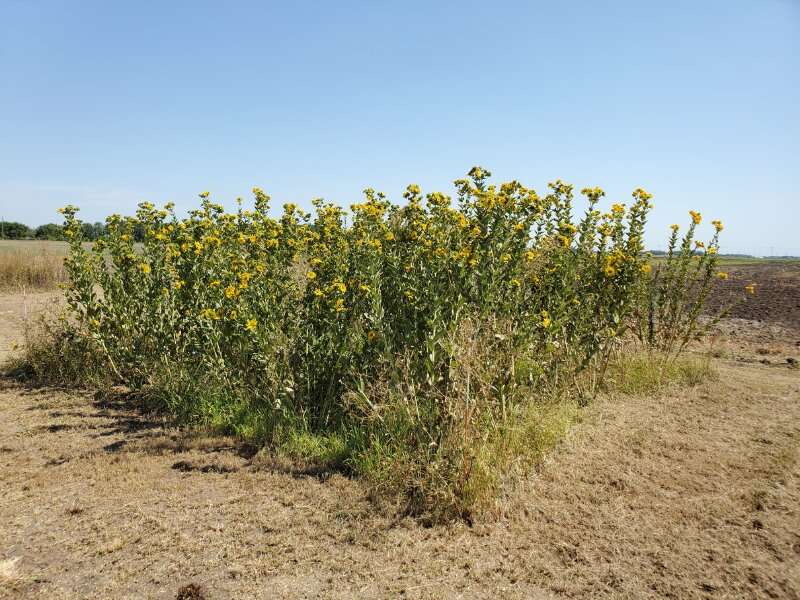Are prairie mixes the only option for crop field borders?

Planting beneficial plants next to gardens and crop fields large and small has been a standard practice for decades, even centuries. The plants provide what are known as ecosystem services. These include attracting pollinators and preventing weeds.
In the grassland regions of North America, prairie mixtures are thought to be the best at providing these services. However, the quality of some of the services they provide can be unpredictable. This is because it is difficult to tell exactly which plants in the mix will grow well.
Ebony Murrell and her team decided to test five perennial grains as alternatives to a nine-species prairie mix. They studied Kernza, silflower, cup plant, sainfoin, and alfalfa.
Murrell presented this research at the 2021 ASA-CSSA-SSSA Annual Meeting held in Salt Lake City, UT.
They looked at five different ecosystem services. These included how many and what kind of pollinators the plants attracted, as well as biomass production, weed suppression, and forage quality.
The specific characteristics of a plant can make it better or worse at providing certain ecosystem services. For example, the shape and color of a flower can be more attractive to local pollinators. Or a plant can produce a lot of roots near the soil surface that prevent weeds from growing. Large leaves of a species like cup plant may also shade out weeds.

“I’ve learned in my career that people are more interested if you have data that shows those species can provide a variety of services,” Murrell says. “The goal of this project was to quantify how well a suite of these crops provided these services. This allows interested growers to decide which one(s) to plant based on their individual needs.”
The results revealed many important details about the services provided by the alternatives. Murrell says three findings rise to the top.
As the researchers predicted, the prairie mix did provide the best pollinator services in terms of diversity and abundance throughout the season.
Two of the alternatives they studied, silflower and cup plant, exhibited a great balance of services. They provide good weed suppression, pollinator services, and forage quantity and quality. The researchers note that they may be the best overall alternatives.
Lastly, an alternative called sainfoin did poorly because it was not competitive with weeds, suggesting that in Kansas it would not serve well as a border crop.

While it hasn’t been tested, the researchers note that these crops may provide other services like increased nitrogen, healthier overall soil, and reduced erosion.
Murrell stresses that there are no “good” or “bad” border crops because it depends on the services needed in a specific field.
“I don’t think it’s as simple as that,” she says. “What growers elect to plant as border crops will depend on what services they’re seeking, their planting and harvesting requirements, and the equipment needed to manage the border crops, etc. A study like this is an excellent starting point. However, it is only one point to consider when making recommendations on what border crop species to plant.”
At the end of the day, the most important aspect of this work, Murrell adds, is to increase diversity of plants in farming systems. She understands how difficult this can be for farmers. She wants to show how planting perennial grains as border crops can provide valuable services and increase diversity.
“I seek to demonstrate that perennial grain candidates as border crops can provide relevant services and encourage farmers to grow these crops and improve diversity on their farms,” she says. “This would be without asking them to make financial sacrifices. In my opinion, this is the most realistic way to help improve diversity in our agricultural landscapes.”
Pollinators contribute to flowering plant diversity
Ecosystem and Agronomic Services Provided By Perennial Herbaceous Crop Species Versus Prairie Mixtures. scisoc.confex.com/scisoc/2021a … lim.cgi/Paper/136364
Citation:
Are prairie mixes the only option for crop field borders? (2022, January 10)
retrieved 10 January 2022
from https://phys.org/news/2022-01-prairie-option-crop-field-borders.html
This document is subject to copyright. Apart from any fair dealing for the purpose of private study or research, no
part may be reproduced without the written permission. The content is provided for information purposes only.
For all the latest Science News Click Here
For the latest news and updates, follow us on Google News.

